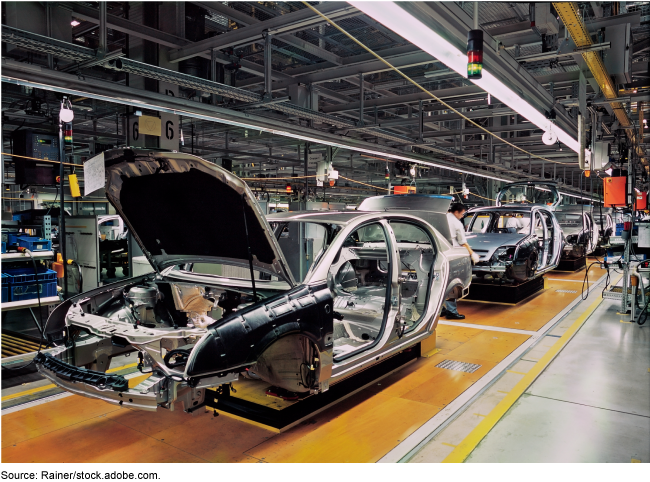International Trade: USTR Should Improve Coordination on New Automotive Rules of Origin
Fast Facts
In 2020, the United States-Mexico-Canada Agreement changed rules for the largest trade category among the partners—automobiles. The agreement, which sets import rules on where materials and labor for autos and parts come from, is expected to raise U.S. automotive prices but also support job growth.
The U.S. Trade Representative chairs an interagency committee responsible for providing advice and input on implementing, enforcing, and modifying the rules. But it doesn't have written guidance on how to track progress or facilitate communication among committee members.
We recommended writing guidance to improve accountability and collaboration.

Highlights
What GAO Found
Agencies used three key mechanisms to coordinate the implementation, verification, and enforcement of the United States-Mexico-Canada Agreement's (USMCA) new rules of origin for automotive goods:
- The Interagency Autos Committee, chaired by the U.S. Trade Representative (USTR), provides advice about and monitoring of the USMCA provisions regarding automotive goods.
- The USMCA Center provided guidance to stakeholders and facilitated verification activities from its inception in March 2020 to its closure in February 2023.
- Customs and Border Protection (CBP) and the Department of Labor (DOL) jointly developed guidance and shared information on certification and verification processes to ensure the value of the labor content of goods (Labor Value Content, or LVC) conforms to requirements.
GAO evaluated the effectiveness of ongoing coordination against selected leading collaboration practices identified in prior GAO work.
GAO's Leading Interagency Collaboration Practices

In its efforts to coordinate on the implementation, enforcement, and verification of new automotive rules of origin, the Interagency Autos Committee generally followed six of the eight leading collaboration practices, as identified in GAO's prior work. However, the committee partially followed two other practices. For example, the committee had not developed written guidance to help ensure accountability. Clearly articulated written guidance could improve communication, limit uncertainty for agencies and stakeholders, and aid in the monitoring of progress toward committee outcomes.
CBP and DOL have generally followed all eight of the leading collaboration practices during their implementation of the LVC certification process and planning for LVC verifications. Their LVC guidance details the agencies' roles and responsibilities, as well as other leading collaboration practices, for these two processes. In addition, GAO found that no significant interagency coordination takes place for enforcement of the new rules of origin, because CBP alone conducts those activities. According to officials, CBP has not yet enforced some of the requirements because the final set of rules of origin regulations are awaiting approval.
Why GAO Did This Study
The USMCA, which replaced the North American Free Trade Agreement, entered into force in July 2020. According to agency officials and industry stakeholders, this change was significant because it strengthened the rules of origin for automotive goods with a potentially widespread effect on trade. USMCA implementing legislation includes a provision for GAO to review the effectiveness of U.S. interagency coordination on implementation, enforcement, and verification of the automotive rules of origin, and the customs procedures of the USMCA with respect to automotive goods.
In this report, GAO examines (1) what mechanisms U.S. agencies use to coordinate on the new rules of origin; and (2) the extent to which relevant agencies are effectively coordinating the implementation, enforcement, and verification of the new rules and customs procedures. GAO reviewed legislation and documents, interviewed agency and labor and industry stakeholders, and analyzed responses from nine agencies that participate on the Interagency Autos Committee against leading interagency collaboration practices, identified in prior GAO work.
Recommendations
USTR, as chair of the Interagency Autos Committee, should work with committee members to develop written guidance.
Recommendations for Executive Action
| Agency Affected | Recommendation | Status |
|---|---|---|
| Office of the U.S. Trade Representative | USTR, as Chair of the Interagency Autos Committee, should work with committee members to develop written guidance that helps ensure accountability and reflects other leading collaboration practices, as appropriate. The guidance should include defining how the committee tracks, monitors, and communicates progress towards outcomes, such as providing recommendations for future modifications to USMCA rules of origin. |
Commenting on this report, USTR accepted GAO's recommendation and agreed to work with its interagency partners to develop written guidance to enhance coordination. In November 2024 USTR promulgated guidance for the committee, specifying agency roles and responsibilities and anticipated timelines for the biennial report and requests to modify ASRs, which fully addressed the recommendation.
|
